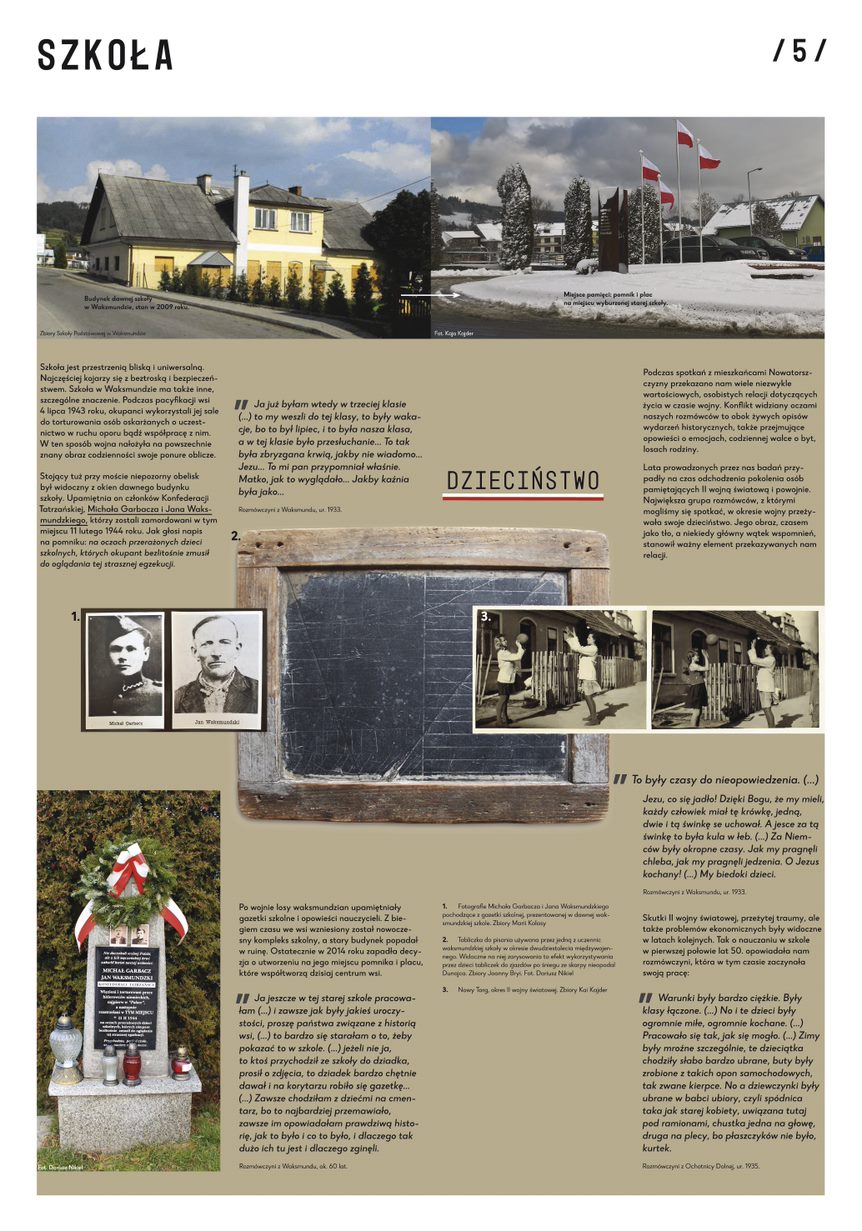
THE SCHOOL
A school is a familiar, universal space, usually associated with carefreeness and safety. The school in Waksmund, however, has another, special meaning. During the pacification of the village, on 4th July 1943, soldiers of the occupying army used its rooms to torture the people accused of membership in or cooperation with the resistance. The familiar image of everyday life was thus tainted with the dark shadow of war.
I was already in third grade back then (…) and we came into that classroom, it was summer holiday, it was July, and it was our classroom, and in that classroom there was an interrogation… It was so spattered with blood, as if who knows what… Jes[us]… You just made me remember. Mother [of God], how it looked… As if some execution… – female interviewee from Waksmund, b. 1933.
Looking out from the windows of the old school building, one could see an unassuming obelisk located by the bridge. It is still standing today, and commemorates two members of the Tatra Confederation, Michał Garbacz and Jan Waksmundzki, killed at the spot on 11th February 1944. As stated by the inscription on the monument, they died: in front of terrified school children, whom the occupier mercilessly forced to witness this horrid execution.
After the war, the stories of Waksmund’s residents were commemorated by school bulletins and tales told by teachers. In time, a modern school complex was built in the village, and the old building fell into disrepair. In 2017 it was replaced by a memorial site: a monument and a square, which now are one of the central points of the village.
I still got to work in that old school (…) and every time there was some celebration, associated with the history of the village, (…) I would take every effort to show at the school. (…) if not me, then someone from the school would go to their grandfather, would ask for photos, and the grandfather happily provided them and a bulletin would be made on the corridor wall… (…) I always took the children to the cemetery, because it spoke to them best, I always told them the true story, how life had been and what it had been, why there are so many of them here and why they died – female interviewee from Waksmund, age ca. 60.
CHILDHOOD
During our meetings with the inhabitants of the Nowy Targ region, we heard many valuable, personal accounts pertaining to life in wartime. Our interlocutors’ perspective on the conflict included not only vivid accounts of important events, but also poignant stories about emotions, the everyday fight for survival, and family history.
Our research was conducted at a time when the generation that remembered the Second World War and the first post-war years was slowly passing away. The largest group of our interviewees were people who experienced the war in their childhood years. The image of childhood, often constituting the background for, and sometimes the main theme of their memories, was a significant element of the accounts they gave us.
Those were times beyond telling (…) Jesus, the things one would eat! Thank God that we had, everyone had a wee cow, one or two, and a wee piggy, too, that one would keep. And for that piggy there would be a bullet to the head. (…) It was a terrible time, under the Germans. How we wanted bread, how we wanted food. Dear Jesus! (…) We poor children. – female interviewee from Waksmund, b. 1933.
The consequences of the world war, of the experienced trauma, but also of the economic problems, persisted for many years. This is how a teacher who started her first job in the early 1950s described working at a school in that period:
Conditions were very rough. We had combined classes. (…) And these children were all very nice, very lovable. (…) We would work as best as we could. (…) The winters were particularly cold, these poor children came dressed very lightly, in shoes made of car tyres, the so-called kierpce. And the girls were dressed in their grandmothers’ clothes, that is in a skirt like those worn by old women, tied into place below the shoulders, with one headscarf on the head and another thrown over the back, because they had no coats, no jackets – female interviewee from Ochotnica Dolna, b. 1935.
